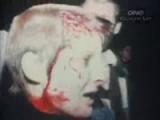What happened that day?
See historic events for any day of the year by entering the date below. Why not try your birthday?
Kiwi of the Week
Today in History

1981 Police baton anti-tour protestors near Parliament
Up to 2000 anti-Springbok tour protesters were confronted by police who used batons to stop them marching up Molesworth St to the home of South Africa’s Consul to New Zealand.
Earlier that day the Springboks had defeated Taranaki in New Plymouth. But the real action occurred on Molesworth St, outside Parliament in Wellington. Police used batons on anti-tour protesters for the first time. Former Prime Minister Norman Kirk’s prediction, made almost a decade earlier, that a Springbok tour would result in the ‘greatest eruption of violence this country has ever known’ now seemed prophetic.
While some of those marching later argued that the momentum of those behind had forced them forward, the police viewed this movement as a blatant refusal to obey orders to halt. Stunned protesters – some covered in blood – reeled away in horror and confusion. Chants of ‘Shame, shame, shame’ broke out and a group of protestors swung back into the city, heading for the central police station to lay assault charges. The nature of protest action and the policing of the tour had taken an irrevocable turn for the worse.
Critics argued that Molesworth St was about the police reasserting their authority in the aftermath of the cancelled game in Hamilton a few days earlier. The police maintained that batons had been used as a last resort. They argued that there were genuine fears for the safety of officers confronted by lines of protesters. After this incident the police made greater use of long batons, which could be thrust at protesters to force them back.
While violence erupted outside New Zealand’s Parliament, Prime Minister Robert Muldoon was in London to attend the wedding of Prince Charles and Lady Diana Spencer. That evening, many New Zealanders were glued to their TV screens to watch the happy couple take their vows, oblivious to the violent events in their capital city.
Image: still from film of Molesworth St protest




















